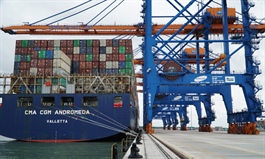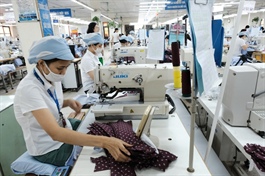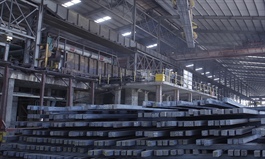Vietnamese manufacturing hit by pandemic
Vietnamese manufacturing hit by pandemic
The Viet Nam Manufacturing Purchasing Managers' Index (PMI) remained at 40.2 in September, signalling a further marked deterioration in business conditions across the sector due to the severe impacts of the COVID-19 pandemic, according to IHS Markit.

In a report released last week, IHS Markit said the Vietnamese manufacturing sector saw a further sharp fall in production during September as the sector continued to be severely impacted by the current wave of the COVID-19 pandemic in the country and the restrictions put in place to try and contain the spread of the virus.
Temporary business closures, transportation difficulties and staff shortages all contributed to a fourth successive reduction in manufacturing output in Viet Nam, and one that remained considerable.
New orders also fell sharply, and to the greatest extent since April 2020. Alongside a sharp reduction in domestic new business, firms pointed to a much sharper reduction in new export orders than that seen during August.
According to IHS Markit, employment levels decreased at the sharpest pace since the survey began in March 2011. Some panellists reported that employees had resigned due to a lack of work, while others scaled back staffing levels amid pauses in production.
The sustained period of restrictions on output and sharply falling staffing levels led to a surge in backlogs of work. Outstanding business rose for the first time in four months, and at a pace that was by far the strongest in the survey's history.
As well as lowering staffing levels, manufacturers also reduced their purchasing activity in response to lower production requirements. Meanwhile, supply-chain delays intensified, with lead times lengthening at a new record pace for the third consecutive month.
Issues with the supply of raw materials contributed to further upward pressure on purchase prices, while there were widespread reports of higher transportation costs. As a result, input prices continued to rise sharply, with the rate of inflation slightly faster than in August. On the other hand, selling prices rose only slightly, and at the weakest pace since June. Firms indicated that weak demand meant they offered discounts in order to try to secure sales.
Restricted production volumes impacted inventory holdings. Inventories of purchases rose as inputs were kept in stock rather than being used in production. In turn, falling output meant that stocks of finished goods continued to decrease.
Firms generally expect output to recover over the coming year, with production set to start rising during the final quarter of 2021 should the pandemic be brought under control and restrictions lifted. Business sentiment picked up from the 15-month low seen in August, but remained relatively muted.
Commenting on the latest survey results, Andrew Harker, Economics Director at IHS Markit, said: “The themes seen in recent months were repeated across the Vietnamese manufacturing sector in September, according to the latest PMI data. Firms again faced huge restrictions on their ability to produce, leading to a steep fall in employment and a surge in backlogs of work following a sustained period of reduced output.”
However, he noted: “On a more positive note, there are signs that the latest wave of the pandemic has peaked and vaccination programmes are making good progress. If cases continue to trend down and restrictions are eased, then firms should be able to see growth resume over the final quarter of the year."
Industrial production
Industrial production in the third quarter of 2021 faced many difficulties due to the complicated development of the COVID-19 pandemic, especially in localities implementing prolonged social distancing measures, said the General Statistics Office (GSO).
According to the GSO report released last Wednesday, the index of industrial production (IIP) in the third quarter decreased by 3.5 per cent over the same period last year. Meanwhile, IIP increased by 6.29 per cent in the first quarter and 11.18 per cent in the second quarter.
However, in the first nine months of this year, the IIP surged by 4.45 per cent over the same period last year.
In the four major industries, the mining industry saw a decrease of 7.17 per cent year on year in this index.
The remaining three industries had IIP increases over the same period last year, including processing and manufacturing (up 6.05 per cent), electricity production and distribution (5.24 per cent), and the group of water supply, management and treatment of waste and wastewater (4.14 per cent).
Due to the impacts of the pandemic, the third quarter was the first quarter of this year with a decrease in IIP.
Meanwhile, this index of some key level 2 industries increased sharply in the first nine months of the year, including metal (up 28.4 per cent year on year); electronic products, computers and optical products (7.7 per cent); apparel (4.8 per cent); leather (4.5 per cent); prefabricated metal products (3.4 per cent); and other non-metallic mineral products (2 per cent).
On the other hand, a number of industries had IIP reductions, such as crude oil and natural gas exploitation (down 12.4 per cent year on year); beverages (4.2 per cent); print (2.2 per cent); and chemical products (1.1 per cent).
The pandemic made this index of many localities fall in the first nine months. Specifically, IIP fell 12.9 per cent year on year in HCM City; 11.2 per cent in Ben Tre; 9.9 per cent in Dong Thap; 9.8 per cent in Can Tho; and 9.5 per cent in Khanh Hoa. Other localities with IIP reductions included Tra Vinh (7.3 per cent) Ba Ria - Vung Tau (5.3 per cent); and Vinh Long (4.5 per cent).
Meanwhile, a number of localities had growth in IIP in the first nine months, including Ninh Thuan (up 32.6 per cent year on year); Dak Lak (25 per cent); Hai Phong (19.7 per cent); Nghe An (18.3 per cent); Gia Lai (17.4 per cent); Ha Tinh (16.6 per cent); Thanh Hoa (15.3 per cent); Quang Ngai (14.9 per cent); Ha Nam (14.4 per cent); and Binh Phuoc (14 per cent).
The GSO also reported that the consumption index of the processing and manufacturing industry in the first nine months increased by 2.8 per cent year on year.
Of which, this index in September increased by 12.4 per cent month on month but decreased by 11.2 per cent year on year.
The average inventory rate of the processing and manufacturing industry in the first nine months was 81.1 per cent, higher than the rate of 75.6 per cent in the same period last year.
In September, the inventory index of this industry increased by 3.5 per cent month on month and 28.2 per cent year on year.






















